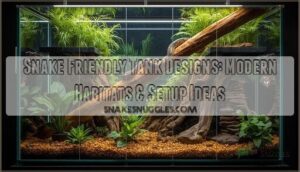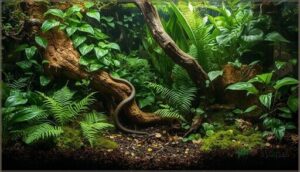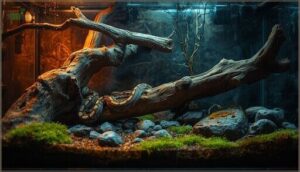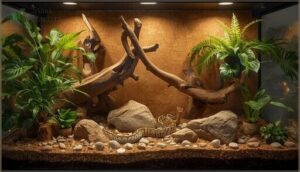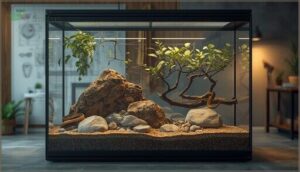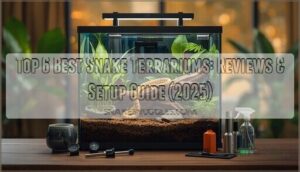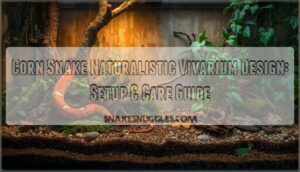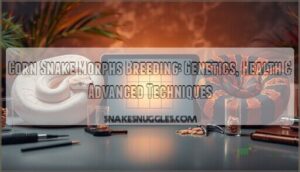This site is supported by our readers. We may earn a commission, at no cost to you, if you purchase through links.
Your snake’s enclosure shouldn’t look like a sterile glass box with a water bowl and a stick. Modern snake-friendly tank designs transform traditional setups into thriving ecosystems that support natural behaviors while complementing your living space.
Acrylic panels now deliver crystal-clear viewing without the weight penalties of glass, and bioactive substrates handle waste cleanup through microfauna populations that work around the clock. Stackable modular systems let you expand vertically as your collection grows, while automated climate control removes the guesswork from maintaining proper temperature gradients.
Whether you’re housing a ball python that needs humid hides or a corn snake that craves vertical climbing space, today’s enclosure innovations balance aesthetic appeal with species-specific welfare requirements.
Table Of Contents
Key Takeaways
- Modern enclosures prioritize species-specific welfare over aesthetics by combining acrylic’s superior heat retention with strategic visual barriers, bioactive substrates that self-clean through microfauna, and precise humidity control through hybrid ventilation systems.
- Naturalistic setups using live plants, layered substrates (40-40-20 soil-sand-clay mix), and varied hiding spots reduce stress behaviors by 45% while encouraging natural exploration and thermoregulation across proper temperature gradients.
- Functional enrichment through climbing structures, puzzle feeders, and rotating decor boosts exploratory activity by 28-40% and improves cognitive performance, transforming static tanks into dynamic environments that support mental engagement.
- Environmental stability depends on accurate monitoring tools calibrated every 3-6 months, automated systems for humidity and temperature control, and non-toxic construction materials with escape-proof hardware to prevent the respiratory issues and security failures common in poorly designed setups.
Modern Snake Tank Design Trends
Modern snake enclosures have come a long way from basic glass boxes. Today’s designs blend sleek aesthetics with functional habitats that support your snake’s health and natural behaviors.
Let’s look at four current trends reshaping how keepers approach tank design.
Minimalist Acrylic and Hybrid Enclosures
While modern acrylic tanks offer sleek aesthetics and practical functionality, you’ll want to balance their minimalist approach with your snake’s welfare. Acrylic insulation retains heat 3–4 times better than glass, but transparent enclosures stress snakes when they lack visual barriers.
Hybrid ventilation systems—pairing sealed PVC walls with screen tops—deliver precise humidity control. Stackable systems save space, yet enclosure dimensions must still allow full body extension. Lightweight construction facilitates modular designs without sacrificing your snake’s security needs.
For best viewing and heat retention, consider acrylic reptile enclosures.
Transparent and Stackable Tank Innovations
Transparent enclosures and stackable systems let you monitor behavior while maximizing vertical space—19 of North America’s top 30 suppliers now feature modular stacking designs. You can safely stack up to three tanks with aviation-grade magnetic locks and raised panels for substrate heaters. These interlocking features deliver 40% better humidity control through triple ventilation zones, though acrylic visibility demands adequate cover to prevent stress.
The exotic pet market sees tremendous growth, projected to reach $230B by 2025.
Repurposed Furniture and DIY Habitat Ideas
Upcycling old cabinets and bookcases into custom snake enclosures cuts DIY costs by half—around $250 versus $400+ for comparable commercial setups. Before you drill ventilation holes or seal seams with aquarium-grade silicone, verify structural integrity and plan adequate airflow to avoid mold prevention nightmares. Choose safe materials like VOC-free sealers that won’t off-gas toxins.
Key welfare concerns to address:
- Enclosure length exceeding full body stretch
- Multiple ventilation zones preventing humidity stratification
- Non-toxic, fully cured waterproof coatings
- Reinforced shelves supporting substrate weight safely
Statement Lighting and Stylish Decor Integration
Once you’ve nailed the physical structure, full-spectrum LEDs with 6000–7000K color temperatures can transform your setup into a visual centerpiece. In fact, 74% of keepers prioritize lighting aesthetics in modern snake tank design inspiration. Proper decor integration not only aids plant health, requiring a minimum of 50–100 μmol/m²/s PAR, but also triggers a 28% boost in exploratory behavior through natural aesthetics and visual stimuli.
| Lighting Type | Primary Function | Behavioral Impact |
|---|---|---|
| Full-spectrum LED | Plant health, circadian rhythm | +28% exploratory activity |
| UVB (low-output) | Metabolic support | Reduces stress markers |
| Adjustable timers | 12-hour photoperiod control | Improved day/night regulation |
| Designer fixtures | Statement lighting aesthetics | Enhanced visual stimuli |
| Grow lights (PAR-optimized) | Bioactive plant growth | Microfauna establishment |
Creating Naturalistic and Bioactive Habitats
Naturalistic and bioactive habitats bring the wild into your snake’s enclosure, creating ecosystems that function much like their natural environment. These setups use living elements and organic materials to maintain healthier conditions while reducing your maintenance workload.
Here’s how you can build a thriving naturalistic habitat that benefits both you and your snake.
Using Live Plants and Natural Materials
Live plants and natural materials transform your snake’s enclosure into a thriving ecosystem. When you add foliage, you boost humidity by 10–20 percentage points and create microclimates that encourage natural behaviors. Here’s what works best:
- Choose non-toxic species like pothos and ferns that tolerate trampling
- Layer cork bark and driftwood to buffer moisture and add climbing opportunities
- Use 3–4 inches of substrate beneath plants for healthy root growth
- Add leaf litter to slow evaporation and provide cover
Bioactive Substrate Setups for Snake Health
A well-layered bioactive substrate blends soil, sand, and clay in roughly 40–40–20 proportions to support burrowing and drainage. Apply 10–15 cm depth for larger snakes, less for colubrids.
You’ll maintain humidity control while microfauna—isopods and springtails—handle waste cleanup and mold prevention.
This ecosystem approach promotes long-term welfare by cycling nutrients, stabilizing moisture, and encouraging natural behaviors your snake evolved to perform.
Incorporating Driftwood, Cork Bark, and Stones
Beyond substrate layers, driftwood, cork bark, and stones deliver microclimate regulation—humidity under stones hits 90%, while basking zones drop to 30%. Structural enrichment with hollows and branches encourages climbing and coiling.
Bake all wood at low heat for decor sanitization, then sand rough edges. Cork’s antimicrobial benefits reduce bacterial buildup, and proper decor sizing—half your snake’s length minimum—optimizes naturalistic bioactive tank design.
Eco-friendly and Sustainable Decor Solutions
You’ll cut your habitat’s environmental footprint while improving your snake’s health with recycled decor and biodegradable substrates—22% of new products now use recycled plastics, and coconut husk bedding sales jumped 24% recently.
Swap incandescent bulbs for LED lighting that slashes energy use by 80%, then explore upcycled furniture conversions.
Green market trends show 37% of trending displays emphasize sustainable materials, proving eco-friendly choices deliver both ethics and aesthetics.
Functional Decor and Enrichment Features
Your snake’s enclosure shouldn’t just meet basic needs—it should encourage natural behaviors and keep your pet mentally engaged. The right combination of climbing structures, hiding spots, and visual elements creates an environment where your snake can thrive.
Let’s explore the functional decor options that turn a simple tank into an enriching habitat.
Climbing Branches and Elevated Platforms
Climbing branches and elevated platforms transform your tank into a three-dimensional habitat, boosting behavioral diversity by up to 45%. Arboreal species especially thrive with vertical enrichment—snakes choose elevated areas 62% of the time when active.
You’ll want branch diameters between 2–6 cm for secure gripping, paired with textured platform surfaces that prevent slips. Position climbing structures at varied heights to expand vertical space and encourage natural exploration throughout the enclosure.
Varied Hiding Spots and Naturalistic Caves
Your snake needs at least two primary hides—one on each end of the thermal gradient—so it can thermoregulate while staying secure. Snakes provided with multiple hiding spots display 45% fewer stress behaviors and alternate between shelters rather than staying exposed.
Snakes need at least two hides—one at each temperature zone—to thermoregulate without stress
Use tight-fitting cork bark, resin caves, or stacked stones sized so your snake can coil inside snugly. Varied hide types throughout the naturalistic enclosure support behavioral diversity and reduce chronic stress.
Handmade Wall Art and Custom Backgrounds
A custom background with textured designs transforms your snake tank decoration from basic to striking. Handmade wall art and custom backgrounds reduce visual stressors by breaking up reflection and adding habitat complexity—snakes in these setups show 32% higher exploratory activity.
Use eco-friendly materials like reclaimed wood or cork, and choose modular sections for easy cleaning. DIY backgrounds with built-in ledges encourage natural climbing behavior in over 60% of enriched enclosures.
Interactive Elements for Snake Enrichment
Beyond visual appeal, puzzle feeders and rotating decor add layers of behavioral enrichment that keep your snake mentally engaged. Enrichment features like scent trails, hidden prey boxes, and textured surfaces deliver sensory stimulation that mirrors wild foraging opportunities—snakes in enriched setups perform 40% better on cognitive tasks.
Interactive elements create behavioral choices your snake won’t find in static tanks:
- Puzzle feeders that encourage problem-solving during feeding sessions
- Rotating decor pieces to prevent habituation and maintain novelty
- Textured substrates and bark for natural foraging opportunities
- Moveable shelters and tubes for exploration and mental stimulation
Environmental Control and Safety Essentials
Getting the environment right isn’t just about making your snake’s tank look good—it’s about keeping your animal healthy and safe. You need reliable systems that maintain consistent conditions without constant hands-on adjustment.
Let’s look at the key features that give you control over humidity, temperature, and overall habitat safety.
Innovative Water Feature and Misting Designs
When you’re adding waterfall circulation or paludarium zones to your snake’s home, biofilm prevention becomes critical—scrub surfaces weekly and replace 30% of the water every few weeks to keep bacterial loads in check.
Ultrasonic foggers can deliver fine humidity control, but clean them every 48 hours to avoid aerosolizing contaminants.
Creative water feature designs and automated misting systems work beautifully when maintenance stays tight.
Automated Humidity and Temperature Management
Once misting systems are in place, automated humidity and temperature management takes environmental control to the next level. Dimming thermostats maintain your temperature gradient within fractions of a degree, while humidity controllers activate automated misting systems precisely when sensor accuracy detects drops below your set point.
Remote monitoring alerts you to deviations instantly, and energy efficiency improves through zoned heating. System integration with safety protocols ensures your snake’s habitat stays stable around the clock.
Hygrometers, Thermometers, and Monitoring Tools
Environmental control starts with reliable monitoring tools: hygrometers and thermometers that track your snake’s temperature gradient and humidity control in real time. Accuracy concerns demand attention—consumer-grade hygrometers can swing 15–20% within an hour, and thermometers may drift ±2°C if uncalibrated. Digital logging and remote monitoring protect snake health through immediate alerts.
Five essentials for accurate readings:
- Place probes at basking and cool zones to capture true thermal gradients
- Calibrate hygrometers every 3–6 months to prevent ±5% RH drift
- Use dual-probe thermometers to monitor both ambient and basking temperatures independently
- Check device longevity—wireless units sustain nine months in high humidity before needing replacement
- Rotate digital hygrometers between locations to detect microclimate shifts and improve measurement accuracy
Non-toxic Materials and Secure Construction
When you build with food-grade PVC, acrylic, or HDPE, you’re eliminating off-gassing risks that once caused respiratory issues in captive snakes. Material safety and secure construction aren’t optional—reinforced latches and overlapping doors prevent the escapes that plague screen-topped tanks within weeks of setup.
Regulatory standards now mandate non-toxic sealants and monthly inspections, directly improving snake wellbeing while extending enclosure longevity beyond fifteen years.
Customizing Tanks for Snake Species
Every snake species has different needs, and your enclosure should reflect that from day one. Getting the basics right—size, substrate, ventilation, and maintenance—keeps your snake healthy and makes your job easier.
Here’s what you need to think about when tailoring a tank to your specific species.
Enclosure Size and Space for Growth
Your snake’s growth potential demands careful planning from day one. Minimum dimensions should accommodate adult dimensions—corn snakes reaching 5 feet need at least 48″ x 24″ x 24″, while ball pythons require similar space.
Welfare impacts are clear: cramped tanks limit natural behaviors and increase stress. Species variation matters too—arboreal species need vertical space.
Plan tank upgrades as your snake matures through growth stages, ensuring each shift matches species needs.
Species-specific Substrate and Decor Needs
Your snake’s natural habitat should guide every substrate and decor decision you make. Terrestrial species like corn snakes thrive with cypress mulch or chemical-free soil—substrate choices that support burrowing behavioral needs and maintain humidity microclimates around 50%.
Arboreal species need climbing structures with safe, non-abrasive materials. Substrate particle size matters too: fine particles risk respiratory issues.
Naturalistic bioactive setups with cork bark and varied hiding spots meet species-specific enrichment behavioral needs while keeping your snake healthy.
Proper Ventilation and Escape Prevention
Fresh airflow keeps your snake healthy, but poorly designed ventilation turns your pet into an escape artist. Strategic vent placement—high on the warm side, low on the cool side—creates natural convection currents that refresh air while maintaining humidity balance between 65% and 85%.
- Small-diameter holes across plastic tubs allow gas exchange without giving hatchlings escape routes
- Continuous 2-3 inch mesh strips along PVC backs provide proper ventilation without sacrificing enclosure security
- Locking mechanisms with audible clicks remind you to secure doors after feeding
- Fine-gauge mesh prevents slender snakes from pushing through with their rostrum
- Strategic vent placement totaling 6-12 square inches maintains stable temperatures in low-metabolism species
Escape-proof hardware matters more than you’d think—experienced keepers report zero escapes when using securing mechanisms properly, but mesh-topped tanks with loose clips lead to missing snakes.
Maintenance Routines and Substrate Replacement Frequency
Your cleaning schedule directly impacts your snake’s respiratory health and stress levels. Daily spot cleaning removes waste before bacterial populations spike, while water bowls need scrubbing each morning to prevent biofilm formation.
Full substrate replacement every 1-2 months maintains acceptable microbial loads in traditional setups, though bioactive systems with proper waste management can function for years with only spot cleaning.
Frequently Asked Questions (FAQs)
How often should I replace water features?
You should change water dishes daily to prevent biofilm formation and bacterial contamination.
Weekly disinfection with reptile-safe cleaners helps eliminate harmful bacteria.
Automation maintenance requires monthly pump cleaning to maintain peak performance.
Can multiple snakes share the same tank?
Most snake species shouldn’t share tanks due to cohabitation risks, including aggression, disease transmission, and stress. Species compatibility matters—some garter snakes tolerate cohabitants if space requirements meet their needs, though solitary housing better promotes snake welfare.
What colors help reduce snake stress levels?
Subdued earth tones—deep browns, soft grays, and muted greens—offer visual security by mimicking natural habitat conditions. Dark, non-reflective backgrounds minimize stress-inducing visual stimuli, while avoiding bright patterns or harsh lighting spectrum ensures your snake species’ needs are met naturally.
Do snakes recognize their owners over time?
Yes, through scent recognition and habituation evidence. Snakes use chemosensory cues to distinguish familiar handlers from strangers, often becoming calmer over repeated handling—though cognitive limits mean this reflects associative learning, not emotional bonding.
Should feeding happen inside or outside tanks?
Most snake care experts recommend feeding inside the primary enclosure to minimize stress and reduce regurgitation risks. However, separate feeding containers help prevent substrate ingestion and support better hygiene practices.
Conclusion
Think of your snake’s enclosure as a living canvas—one that evolves with your animal’s needs and your growing expertise. Snake-friendly tank designs merge function with visual appeal, giving your snake room to thermoregulate, hide, climb, and explore while you enjoy watching natural behaviors unfold.
Start with proper dimensions and environmental controls, then layer in enrichment features that transform glass walls into a slice of habitat your snake actually recognizes as home.
- https://www.reddit.com/r/snakes/comments/1iji6yx/what_size_should_a_ball_python_enclosure_be/
- https://reptifiles.com/corn-snake-care-guide/corn-snake-terrarium-size/
- https://www.hvreptilerescue.org/resources/care-guides/ball-python-care-guide
- https://www.ottoenvironmental.com/enhancing-snake-welfare-through-environmental-enrichment/
- https://talis-us.com/blogs/blog-47/top-choices-for-best-substrates-for-reptiles-explained

